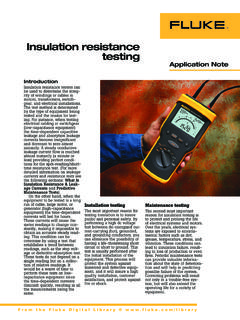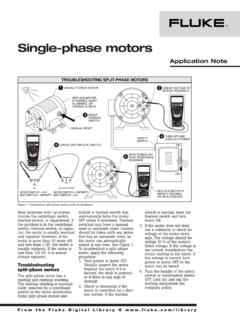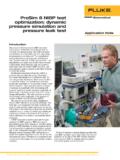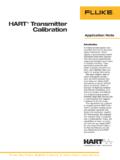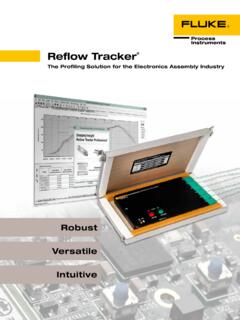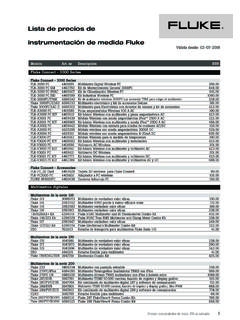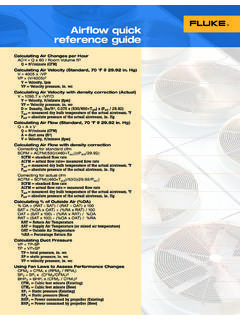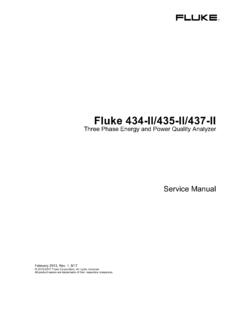Transcription of lethality - Fluke Corporation
1 F0 Calculations lethality Calculations Dr Steve OffleyPage 1 of 17. Food Product Manager F0 Calculations Food lethality Calculations - F0 value The following document aims to explain the use of the F 0 calculation to quantify bacteria death rates in cooking processes. Food poisoning comes in many forms but is in general caused by the human consumption of toxins released as a by - product of bacterial growth within food. To limit bacterial growth it is imperative that handling, processing, storage and transportation of food is carried out correctly. A schematic showing the effect of temperature on bacterial activity is shown below. Effect of Temperature on Bacteria Growth 101 C / 212 F. Temperatures destroy most bacteria though not all toxins 75 C / 165 F. Temperatures prevent growth, but allow survival of some bacteria 60 C / 140 F. Many bacteria survive and some growth may occur 49 C / 120 F.
2 Rapid growth of bacteria and production of toxins by some bacteria 16 F / 60 F. Some growth of food-poisoning bacteria may occur 5 C / 40 F. Slow growth of some bacteria that cause spoilage may occur 0 C / 32 F. Freezing temperatures will stop growth of bacteria, but will not kill them. -30 C / -20 F. -20 F. -20 F. -20 F. Danger Zone for potentially hazardous foods (Milk, eggs, fish, poultry, etc.). To kill bacteria at source two thermal processes are employed within the food industry, Sterilisation and Pasteurisation. The choice of process used is governed by the type of food product and additional forms of food preservation applied. Page 2 of 17. F0 Calculations Sterilisation Clostridium Botulinum Sterilisation is applied to food products that undergo no additional preservation regimes such as chilling or freezing and have had no preservation ingredients added to the product (Sugar, salt, vinegar, acid, alcohol, lemon juice etc ).
3 The effect of preservatives on pH will generally govern whether a product should be Pasteurised or Sterilised. Food Product pH < Pasteurise Food Product pH > Sterilise Sterilisation is in most cases applied to canned and other packaged foodstuffs (glass jar / plastic pouch, vacuum packed) which are stored at room temperature after processing without additional preservation. Without secondary preservation the most lethal bacterial threat is the anaerobic organism Clostridium Botulinum. Sterilisation is essential to kill such bacteria at source. For this reason Clostridium Botulinum is chosen as the ideal bacteria to model the effectiveness of a Sterilisation procedure. For Clostridium Botulinum a Sterilisation temperature of C is required to kill the bacteria. Sterilisation is defined by F03 (equivalent to heating for 3 minutes at 121 C) to achieve twelve log reductions in the population of Clostridium Botulinum present in the food.
4 Foods subjected to such treatment are stable at ambient temperatures and therefore considered commercially sterile. Pasteurisation Pasteurisation is applied to any food stuff where in addition to thermal processing other forms preservation are applied that would prevent the growth of Clostridium Botulinum (chill storage, reduced water activity, reduced pH and or high salt content). The target organism considered for Pasteurisation is governed by the type of food being processed. Thermal processing conditions required to kill different organism will vary but are documented in legislative procedures. Pasteurisation temperatures required to kill this group of bacteria are significantly lower than C used for Sterilisation. Eschericha coli Salmonella Salmonella Raw meats, Poultry, Eggs , Milk, Fish, Shrimp Escherichia coli Uncooked minced beef, Unpasteurised Milk Listeria Monocytogenes See Appendix for further general information on Clostridium Botulinum and Listeria monocytogenes.
5 Page 3 of 17. F0 Calculations Bacteria Death Kinetics lethality Kinetics For sterilisation processes the spore Clostridium Botulinum is used to quantify the effectiveness of bacterial kill as it is the most heat resistant pathogenic organism. At a temperature of C (250 F) 90% of the spore population is killed in minutes. This time is known as the decimal reduction time. DT = Decimal Reduction Time Time in minutes required at constant heating to reduce the number of surviving spores by a factor of 10 (90% reduction in population) which is also referred to as one logarithmic reduction. The DT is calculated by using first order kinetics as shown below. DT = Decimal Reduction Time at Temperature T. Log[Spore Population]. Clostridium Botulinum T Ref = C. 1. DT. Heating Time (mins). In food industry it has been decided that for sterilisation it is necessary that a minimum of 12.
6 Log (or decimal) reductions of the Clostridium Botulinum spore population be achieved. This requirement is quantified using the term F0. F0 = [ No Decimal Reductions][DT]. Target F0 for Clostridium Botulinum = 12 x D = 12 x mins = mins (~ 3). In practise as a safety issue the minimum target F0 value is doubled to 6. Page 4 of 17. F0 Calculations Pasteurisation procedures follow the same principles as the F0 calculation but with the one exception that the bacteria spore and associated temperatures used to model the process are product specific. Legislative procedures document what bacteria should be used for each food type and gives recommended F0 values that should be attained. In most pasteurisation procedures it is common that the F0 value be described as Pu or P. value. For Pasteurisation it has governed that for safe processing a minimum of 6 log reductions (decimal reductions) be achieved.
7 Pu = [ No Decimal Reductions][DT]. In soups the target bacteria is Botulinum Type E. At a reference temperature of 90 C the decimal reduction time is quoted as minutes. Applying these figures to the calculation;. Target Pu for Botulinum Type E = 6 x mins = mins Although the target figure is industry consensus has agreed that the safe Pu value for Botulinum Type E should be a minimum of 10. Tables of agreed Pu values for food groups are available from food legislative bodies. Simplification of the F0 or Pu unit for the above example a Pu value of 10 mins means in practise that if the food product is heated to 90oC and held exactly at that temperature for 10. mins the Botulinum Type E bacteria population would be reduced by 6 log reductions. The Decimal Reduction Time (DT) is quoted for a specific temperature T. In a real life situation, in food processing it is impossible to achieve a constant temperature (ramp up, cool down, hot and cold spots within oven retort etc).
8 To address this issue the Z value is derived which is the first order relationship between the decimal reduction time and heating temperature. The Z value is the temperature difference required to effect a ten-fold change in the decimal reduction time. The z value is often described as being the relative killing power of the heating temperature. For a pasteurisation process if the z value is calculated to be 6 C a change in product temperature of 6 C will require an order of magnitude change in heating time to achieve the same degree of pasteurisation. 1 min @ 60 C = min @ 66 C = min @ 72 C = 10 mins @ 54 C. The Z value ( C) is derived experimentally by plotting the logarithmic DT value against Heating Temperature as shown below. Page 5 of 17. F0 Calculations Z = kinetic factor Clostridium Botulinum Log[DT]. Z = 10 C. 1. Z. Temperature ( C). Having derived the Z value it is possible compare numerically the relative lethality of different process temperatures using equation 1.
9 Equation 1: lethality Rate Calculation L = log 10 1 [ (T - Tx ) / z ] = 10 [ (T Tx) / z ]. L = lethal Ratio or Lethal rate (mins). T = Temperature under consideration ( C). Tx = Reference Temperature ( C). Z = Kinetic factor The above expression can be used to determine how effective a cook process will be when the process temperature does not match exactly the reference temperature at which decimal reduction times are quoted. (See Example 1 on next page). Page 6 of 17. F0 Calculations Example 1: Pasteurisation of Beef Organism Listeria Monocytogenes Temperature Reference 62 C. Z Value C. Decimal Reduction Time* mins * 1 decimal / log reduction in L. Monocytogenes population From such data and the lethality calculation it is possible to calculate the equivalent process duration for other product temperatures as illustrated below. Product core temperature = 77 C.
10 L = 10 [ (T Tx) / z ]. L = 10 [ (77 62) / ]. = 10 [ ]. L = The lethality rate for the destruction of Listeria Monocytogenes is higher at 77 C than at 62 C. Therefore, heating a product at 62 C for 1 min is equivalent in lethality (kill same population of Listeria Monocytogenes) to heating the same product at 77 C for 1 mins ( s). For some situations different kinetic factors are applied depending on whether the process core temperature is above or below the reference temperature. - If the process temperature is below the reference temperature use the lower z value - If the process temperature is above the reference temperature use the higher z value As a basic rule of thumb it is always assumed that the z value giving the longest therefore safer process heat duration should be used (worst case scenario). In a real life situation a product experiences a range of different temperatures as it heats up during the cooking / pasteurisation process.
